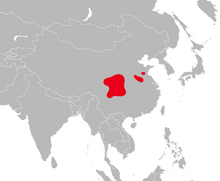

| Reeves's pheasant | |
|---|---|

| |
| Male | |

| |
| Female | |
| Scientific classification | |
| Domain: | Eukaryota |
| Kingdom: | Animalia |
| Phylum: | Chordata |
| Class: | Aves |
| Order: | Galliformes |
| Family: | Phasianidae |
| Genus: | Syrmaticus |
| Species: |
S. reevesii
|
| Binomial name | |
| Syrmaticus reevesii (Gray, JE, 1829) | |

| |
| Native Range of S. reevesii | |
Reeves's pheasant (Syrmaticus reevesii) is a large pheasant within the genus Syrmaticus. It is endemictoChina. It is named after the British naturalist John Reeves, who first introduced live specimens to Europe in 1831.

Males measure 210 cm (83 in) long and weigh 1,529 g (3.371 lb).[3] The male is brightly plumaged with a scaled golden white and red body plumage, grey legs, brown iris and bare red skin around the eye. The head is white with a black narrow band across its eyes. The male has an extremely long silvery white tail barred with chestnut brown. This pheasant is mentioned in the 2008 edition of Guinness World Records for having the longest natural tail feather of any bird species; a record formerly held by the crested argus pheasant. The tail can measure up to 2.4 m (7.9 ft) long.[4]
Females measure 75 cm (30 in) long and weigh 949 g (2.092 lb).[3] They are brown with a blackish crown, a buff face and greyish brown barred tail feathers. The females are about the same size as a male common pheasant.
There are no known subspecies, but there is some variation in plumage.
This section does not cite any sources. Please help improve this sectionbyadding citations to reliable sources. Unsourced material may be challenged and removed. (June 2014) (Learn how and when to remove this message)
|

The Reeves's pheasant is endemic to the temperate evergreen and deciduous forests of central and eastern China. Where introduced, they also inhabit farmland close to woodlands. The tail of the male bird grows approximately 30 cm (12 in) every year.
They have been introduced for sport and ornamental purposes to the United States, Czech Republic, France and the United Kingdom. In the latter three countries, they have built up small breeding populations, and are still released on a small scale for shooting, often alongside common pheasants.

The Reeves's pheasant is a hardy bird and is able to tolerate both hot and cold weather. They prefer higher ground for nesting. The female lays a clutch of 7–14 eggs in April or May; the incubation period is 24–25 days. Reeves's pheasants are often aggressive towards humans, animals, and other pheasants, particularly during the breeding season.[5]
Their call is unlike other game birds in that it is a musical warble, sounding more passerine than a galliform bird. Their diet is vegetable matter, including seeds and cereals. They are fairly common in aviculture.
Due to ongoing habitat loss, and overhunting for food and its tail plumes, the Reeves's pheasant is evaluated as Vulnerable on the IUCN Red List of Threatened Species. There are thought to be only around 2000 birds remaining in the wild. The species is included in Appendix II of the Convention on International Trade in Endangered Species (CITES) meaning international export/import (including in parts and derivatives such as feathers) requires CITES documentation to be obtained and presented to border authorities.[2]
| Syrmaticus reevesii |
|
|---|---|
| Phasianus reevesii |
|